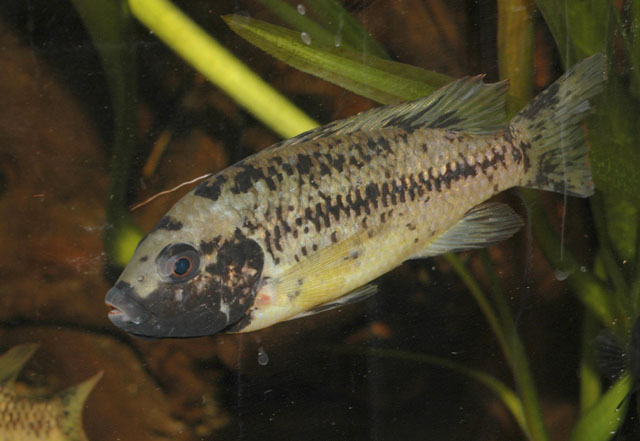|
Dorsal spines (total): 15-17; Dorsal soft rays (total): 10-11; Anal spines: 3-3; Anal soft rays: 8-9; Vertebrae: 29. Diagnosis: mouth terminal (Ref. 26185, 53940). Distinctive fleshy lips (Ref. 26185, 52307), from which protrude rows of outwardly directed jaw teeth (Ref. 26185, 53949). Inner jaw teeth usually with 3 subequal cusps, outer row notched in juveniles but with simple replacements in adults (Ref. 26185, 53940). 7-8 lower outer teeth, 12-23 upper outer teeth; blade and dentigerous area of lower pharyngeal bone subequal, with slender teeth, firm and unicuspid posteriorly; colour variable, often silver-yellow (pale or intense) with dusky mottling concentrated on head and, to a lesser extent, midline (Ref. 26185). No Tilapia-spot on dorsal fin (Ref. 26185, 52307, 53940, 53949). Metallic blue highlights on operculum, dorsal and caudal fins (Ref. 26185).
Description: body robust, relatively deep (35.0-38.5% SL) (Ref. 81260). Snout somewhat rounded (Ref. 52307). Mouth small (Ref. 52307, 53949, 58527, 81260), with teeth clearly visible (Ref. 58527), and jaw teeth with reddish tinge (Ref. 52307). Lower jaw short (Ref. 53949), stout (Ref. 81260) and broad (Ref. 53949, 81260) with with 7-8 robust, procumbent, protruding teeth (Ref. 81260). In upper jaw 18-20, protruding, conical or weakly shouldered unicuspid teeth; lower pharyngeal jaw broadly triangular, a little longer than wide, teeth somewhat compressed and shouldered unicuspids (Ref. 81260). Lips thick (Ref. 52307, 53940). Muscular jaws specially developed (Ref. 52307, 53940) in relation to sponge-eating habits (Ref. 52307). Gill rakers on first gill arch short and conical (Ref. 53949, 81260). 2 series of scales on cheek; 5 scales between bases of pectoral and pelvic fins; 3 anal fin spine shorter than last dorsal; first soft ray of pelvic fin longest, second not much shorter (Ref. 53949).
Coloration: adults entirely silvery-gray or yellowish (Ref. 26185, 52307) to bright yellow (Ref. 58527, 81260), dorsum deeper golden orange (Ref. 81260), with 2 horizontal, poorly defined, black lines (Ref. 58527) made up of many irregular black spots (Ref. 52307, 53940): one in middle of body from opercle to caudal peduncle (Ref. 52307, 53940, 58527, 81260) and another, more diffuse line above lateral line (Ref. 58527) directly under dorsal fin (Ref. 52307, 53940, 81260). Upper black lines on left and right side unite on top of head in front of dorsal fin (Ref. 58527). Throat, cheek (Ref. 52307, 53949, 58527), chest (Ref. 53949, 58527, 81260), chin and operculum usually (dusky) black (Ref. 58527). Dorsal, caudal and anal fins dusky (Ref. 52307). Anterior edge of pelvic fins black (Ref. 52307, 53949). Body and fins with numerous black spots (Ref. 52307, 58527) of variable size (Ref. 58527), including nape, chest, flanks, caudal peduncle and caudal fin base (Ref. 81260). Black coloration becomes greyish under stress; lips sometimes bluish (Ref. 58527). Juveniles chestnut-coloured with more black spots, developing into adult coloration at about 2 years (Ref. 58527). No Tilapia-spot visible (Ref. 26185, 52307, 53949). |

